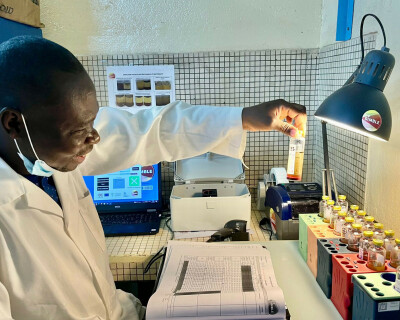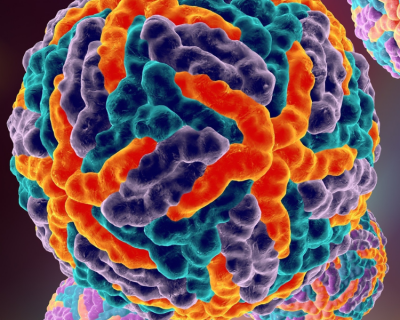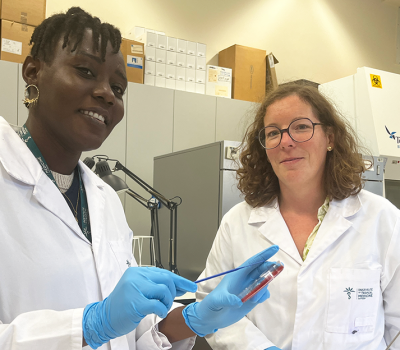Fresh Off The Journal: October 2025

Publication highlights: October 2025
Every year, our ITM researchers, together with their partners, publish around 380 articles in high-impact journals. Each month, we highlight a selection of these publications.
Department of Clinical Sciences

Bridging the gap between autism and HIV care
A multicentre Belgian study led by ITM found that autistic traits are more common among people living with HIV (4%) and PrEP users (8%) than in the general population (2%). Yet only a third had a prior autism diagnosis. The findings reveal an overlooked intersection between autism and sexual health, highlighting the need for autism-friendly care and communication in HIV clinics to improve health access and quality of life.
Huyst, V., Van Praet, J., Tsoumanis, A., Vanbaelen, T., Sauvage, A., Dewinter, J., Noens, I., Van Damme, K., & Roelens, K. (2025). Prevalence of autistic traits in people living with HIV and users of HIV pre-exposure prophylaxis: a cross-sectional study in Belgian HIV reference centres. AIDS Care, 1–16.

No test, no cure: Expanding access to bacteriology diagnostics
With antimicrobial resistance causing nearly 5 million deaths each year, Experts from Belgium, Benin and Canada call for urgent action to make bacteriology diagnostics accessible worldwide. In many African countries, only 1% of labs perform bacterial testing. The authors urge global investment and local innovation to bring reliable culture and antibiotic susceptibility testing to resource-limited settings. Without accessible diagnostics, the fight against drug-resistant infections will remain one step behind.
Hardy, L., Jacobs, J., Yansouni, C., & Affolabi, D. (2025). Revisiting bacteriology diagnostics: how to make them globally available and accessible. Clinical Microbiology And Infection.

Evidence of mpox transmission from mother to baby during pregnancy
ITM and INRB researchers documented the first molecular evidence of transplacental mpox infection across all stages of pregnancy. In three cases from the clade Ib outbreak, the virus was detected in placental and fetal tissues, confirming vertical transmission. Outcomes included pregnancy loss and one live birth with skin lesions. The findings highlight the need for preventive measures, including vaccination and close monitoring of pregnant women during mpox outbreaks.
Vakaniaki, E. H., Kuispond, N. S., Hirata, Y., Bangwen, E., Brosius, I., Kinganda-Lusamaki, E., Ozono, S., Katano, H., Ndunge, L. G., Mulopo-Mukanya, N., Tshomba, J., De Vos, E., Van Dijck, C., Munganga, P., Mukari, G., Mujula, Y., Mambo, D. M., Kitwanda, S. B., Maliyamungu-Bubala, N., . . . Mbala-Kingebeni, P. (2025). Three Cases of Vertical Transmission of Clade Ib Mpox Virus. New England Journal Of Medicine, 392(23), 2385–2387.
Department of Public Health

Understanding men’s lower engagement in HIV services
In Zambia, men are less likely than women to access HIV services, but why? In Lusaka, the Yaba Guy Che study used qualitative research to explore the factors that shape men’s engagement with HIV services. Many men viewed clinics as “women’s spaces,” discouraging testing and treatment access, and feared stigma and isolation if they tested positive. Community-based testing and partner initiatives were considered important to support access. The findings call for male-friendly, stigma-free HIV services that strengthen social support and reframe masculine norms related to health-seeking.
Mwansa, C., Phiri, M. M., Belemu, S., Kalekanya, L., Banda, C., Sigande, L., Ayles, H., Simwinga, M., & Hensen, B. (2025). “A heart of the man is lighter than that of the woman. . .” exploring men’s motivation and capability to access HIV services in Lusaka, Zambia: findings from the Yaba Guy Che study. BMC Public Health, 25(1).
A safer start for mothers and babies with PrEP in pregnancy
In collaboration with South African partners, ITM researchers from the Unit of Sexual Health and HIV led a systematic review that found that while many pregnant and postpartum women start taking oral HIV PrEP, continuation and adherence declined rapidly, especially after birth. Reviewing 12 studies from across Africa, the team showed that integrating PrEP into antenatal and postnatal care can effectively reach women, but long-acting options and person-centred support are essential to keep mothers protected and prevent HIV transmission to infants.
Rotsaert, A., Essack, Z., Bosman, S., Davey, D. J., & Hensen, B. (2025). Oral pre‐exposure prophylaxis initiation, continuation and adherence among pregnant and postpartum women receiving antenatal and postnatal care: a systematic review. Journal Of The International AIDS Society, 28(S5).

Prescribing medicines in the midst of a conflict: the case of Mali
In Mali’s conflict-hit Mopti region, a partnership between researchers from Mali and ITM showed how prescribing practices are shaped by constraints, either directly or indirectly linked to the conflict, such as medicine stock-outs, staff shortages, system disruptions, insecurity, and violence. Faced with such constraints, providers often, out of necessity, deviate from guidelines. Such practices, far from being ‘irrational’, may represent the only way to compensate for the huge impact on conflicts on access to medicines and to healthcare.
Coulibaly, I., Diarra, Y., Ahmed, M. A. A., Ravinetto, R., Doumbia, S., & Kielmann, K. (2025b). Contextual constraints and dilemmas influencing health providers’ prescription practices in a conflict-affected area: Qualitative insights from Mopti, Mali. PLOS Global Public Health, 5(10), e0004621.
Department of Biomedical Sciences

How a mosquito outsmarted time and cities
ITM researchers helped uncover the surprising history of the so-called London Underground mosquito, Culex pipiens form molestus. Genomic analysis of 350 mosquitoes shows that this human-biting form didn’t evolve beneath London’s streets 200 years ago, as long believed, but over 1,000 years ago in the Mediterranean or Middle East, possibly alongside ancient agriculture. The findings rewrite a textbook example of urban evolution and reveal how early human societies primed today’s mosquitoes for the colonization of modern urban environments.
Haba, Y., Korlević, P., McAlister, E., Lawniczak, M. K. N., Schumer, M., Rose, N. H., McBride, C. S., Aardema, M. L., Afonso, M. O., Agramonte, N. M., Albright, J., Alho, A. M., Almeida, A. P. G., Alout, H., Alten, B., Altinli, M., Korba, R. A., Andreadis, S. S., Anghel, V., . . . Zittra, C. (2025). Ancient origin of an urban underground mosquito. Science, 390(6771).

A smarter, simpler way to spot dengue virus RNA
Researchers from ITM’s Virology Unit, together with the University of Antwerp and Ghent University, developed an innovative enzyme-free biosensor that directly detects dengue virus RNA without heating or complex lab steps. By designing probes that help “unfold” the virus’s RNA, it achieved high specificity and high sensitivity at room temperature. This proof-of-concept marks a major step toward faster, affordable point-of-care tests for dengue and other RNA viruses, supporting early outbreak detection in low-resource settings.
Op De Beeck, H., Daems, E., Hauner, A., Colaker, A., Madder, A., K. Ariën, K., & De Wael, K. (2025). Singlet oxygen-based photoelectrochemical biosensor for dengue virus RNA. Microchemical Journal, 218.

Sand fly surveillance strengthens Nepal’s fight against leishmaniasis
A partnership between ITM, partners in Nepal and the Royal Museum for Central Africa mapped sand fly species across 43 districts in Nepal to support the country’s visceral leishmaniasis elimination goal by 2030. The main vector, Phlebotomus argentipes, was found in nearly all areas with active cases, while other potential vectors appeared even in high-altitude regions. Using DNA barcoding, scientists achieved 97% accuracy in species identification, an important step toward stronger surveillance and targeted vector control in Nepal.
Roy, L., Uranw, S., Rai, K., Cloots, K., Das, M. L., Smitz, N., & Van Bortel, W. (2025). Mapping the distribution of phlebotomine sand fly species with emphasis on Leishmania vectors in Nepal and exploring the potential of DNA barcoding for their identification. Scientific Reports, 15(1).
Spread the word! Share this story on











